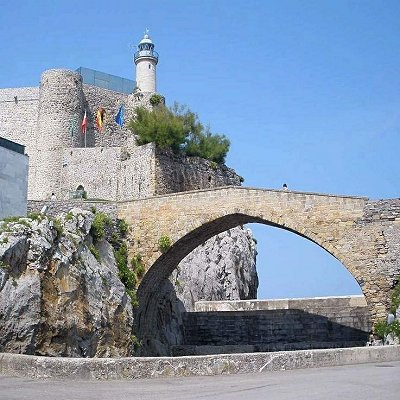
Like us on Facebook
PLACE NAMES


 
|
| Castro Urdiales
|
 |
|
|
Castro Urdiales is a seaport of northern Spain, in the autonomous community of Cantabria, situated on the Bay of Biscay. Castro Urdiales is a modern town, although its castle and the Gothic-style parish church of Santa María de la Asunción, date from the Middle Ages. Its chief industries are tourism, fishing, and the preservation of fish, especially sardines and anchovies, in oil. The Lolin and La Castreña anchovy canning factories serve as a reminder of the town's closeness to this industry and its proximity to the sea.
Although the number of people registered in the town is around 32,000, the summer population can double or even triple this figure. The town is popular because of its beaches and scenic harbor.
Main sights include:
- The monument complex of Castro Urdiales, also known as Puebla Vieja, has medieval origins and is located near the sea. It was declared a Conjunto histórico in 1978.
- The Church of Santa María de la Asunción is in Gothic style. Built under the protection of King Alfonso VIII of Castile in the 13th century (though it was finished in the 15th century), it is a basilica church with three naves. In the interior are the images of the White Virgin and the Reclining Christ, and three Gothic carvings of the Magi. It was declared a National Monument in 1931.
- The Castle of Santa Ana is located near the port and the church of Santa María de la Asunción. In modern times it housed a lighthouse.
- Palace, castle-observatory and Ocharan gardens, protected since 1985. The castle-observatory, dating back to 1914 and designed by local architect Eladio Laredo, is in neo-Gothic style. The Ocharan Palace, or Toki-Eder, was built in 1901, also by the local architect Eladio Laredo. It is an eclectic-style building, with a portico of columns and other elements of Greek taste, and with a multicolored tile frieze designed by Daniel Zuloaga.
- Ruins of the medieval tower of the Templars, in Allendelagua, on the mountain side. It belonged to the Knights Templars and is currently in poor condition.
- Cave of El Cuco, west of the town. It houses rock carvings and paintings from the Upper Paleolithic period, which depict animals such as deers, goats and horses.
- Cave of La Lastrilla
- Cave Grande or de los Corrales
- Cave Aurelia
- Castro of la Peña de Sámano
- Remains of Flavióbriga and the medieval village, protected since 1996. The Flavióbriga archaeological site is under the Old town, two meters deep. Remains of a Roman colony can be visited in the Regional Museum of Prehistory and Archaeology of Cantabria.
- Water driving of El Chorrillo, a work of hydraulic engineering from the Roman age.
- Tower-House of Los Otañes, in Otañes.
- Ruins of the Hospital de la Vera Cruz, in Islares.
- City Hall (16th century)
- Tower-House of Cerdigo, built in Cerdigo between the 17th and 18th centuries.
- Archaeological site of Patera de Otañes, in the village of Otañe.
- Roman mile-stone, opposite the Church of Santa María. Dating to 61 AD, it marked the distance to Pisoraca. It has an inscription that reads "Nero Claudius, son of the divine Claudius, Caesar, Augustus, Germanicus, Pontifex maximus, with the tribunician power for eighth time, the empire for ninth and the consulate for fourth. From Pisoraca one hundred and eighty miles".
- Iglesia de San Pedro (11th century), in Romanesque style.
|
 Feel free to Email me any additions or corrections Feel free to Email me any additions or corrections
LINKS AVAILABLE TO YOUR SITE
| | |





